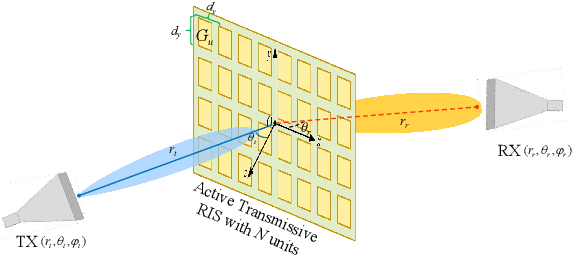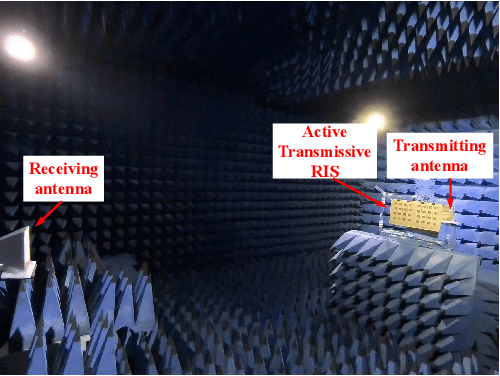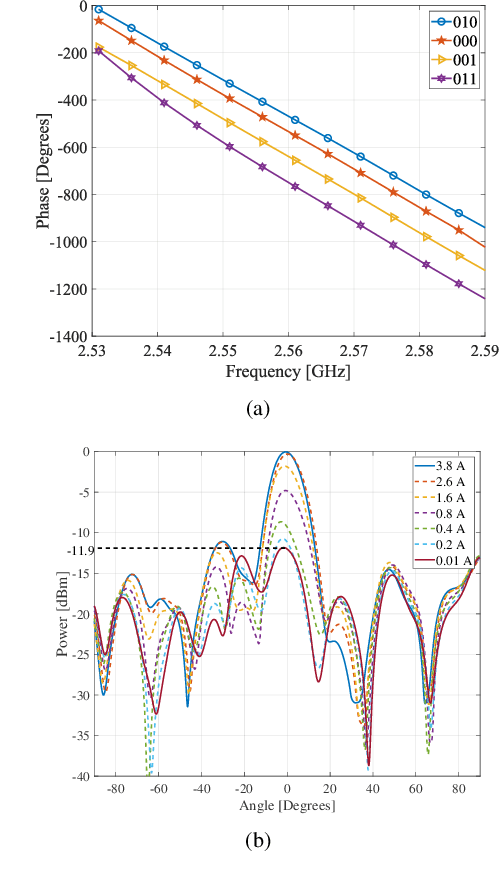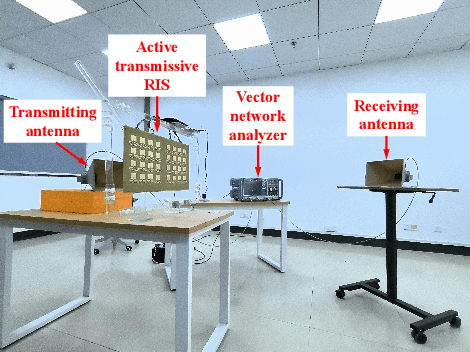Taorui Yang
Design and Prototyping of Filtering Active STAR-RIS with Adjustable Power Splitting
Jan 19, 2025



Abstract:Reconfigurable Intelligent Surfaces (RISs) have emerged as a transformative technology for next-generation wireless communication systems, offering unprecedented control over electromagnetic wave propagation. In particular, Simultaneously Transmitting and Reflecting RISs (STAR-RISs) have garnered significant attention due to their full-space coverage. This paper presents an active STAR-RIS, which enables independent control of both transmission and reflection phases and features out-of-band harmonic suppression. Unlike the traditional passive RIS, the proposed design integrates active amplification to overcome the inherent passive losses, significantly enhancing signal strength and system performance. Additionally, the system supports dynamic power allocation between transmission and reflection modes, providing greater flexibility to meet diverse communication demands in complex propagation environments. The versatility of the design is further validated by extending the Radar Cross Section (RCS)-based path loss model to the STAR-RIS. This design improves efficiency, flexibility, and adaptability, offering a promising solution for future wireless communication systems, particularly in scenarios requiring simultaneous control of transmission and reflection signals.
A Block Quantum Genetic Interference Mitigation Algorithm for Dynamic Metasurface Antennas and Field Trials
Oct 21, 2024



Abstract:This paper proposes a quantum algorithm for Dynamic Metasurface Antennas (DMA) beamforming to suppress interference for an amplify-and-forward relay system in multi-base station environments. This algorithm introduces an efficient dynamic block initialization and overarching block update strategy, which can enhance the Signal-to-Interference-plus-Noise Ratio (SINR) of the target base station (BS) signal without any channel information. Furthermore, we built a relay system with DMA as the receiving antenna and conducted outdoor 5G BS interference suppression tests. To the best of our knowledge, this is the first paper to experiment DMA in commercial 5G networks. The field trial results indicate an SINR improvement of over 10 dB for the signal of the desired BS.
Modeling, Design, and Verification of An Active Transmissive RIS
Oct 16, 2024



Abstract:Reconfigurable Intelligent Surface (RIS) is a promising technology that may effectively improve the quality of signals in wireless communications. In practice, however, the ``double fading'' effect undermines the application of RIS and constitutes a significant challenge to its commercialization. To address this problem, we present a novel 2-bit programmable amplifying transmissive RIS with a power amplification function to enhance the transmission of electromagnetic signals. The transmissive function is achieved through a pair of radiation patches located on the upper and lower surfaces, respectively, while a microstrip line connects two patches. A power amplifier, SP4T switch, and directional coupler provide signal amplification and a 2-bit phase shift. To characterize the signal enhancement of active transmissive RIS, we propose a dual radar cross section (RCS)-based path loss model to predict the power of the received signal for active transmissive RIS-aided wireless communication systems. Simulation and experimental results verify the reliability of the RIS design, and the proposed path loss model is validated by measurements. Compared with the traditional passive RIS, the signal power gain in this design achieves 11.9 dB.
Prototyping and real-world field trials of RIS-aided wireless communications
Aug 07, 2023Abstract:Reconfigurable intelligent surface (RIS) is a promising technology that has the potential to change the way we interact with the wireless propagating environment. In this paper, we design and fabricate an RIS system that can be used in the fifth generation (5G) mobile communication networks. We also propose a practical two-step spatial-oversampling codebook algorithm for the beamforming of RIS, which is based on the spatial structure of the wireless channel. This algorithm has much lower complexity compared to the two-dimensional full-space searching-based codebook, yet with only negligible performance loss. Then, a series of experiments are conducted with the fabricated RIS systems, covering the office, corridor, and outdoor environments, in order to verified the effectiveness of RIS in both laboratory and current 5G commercial networks. In the office and corridor scenarios, the 5.8 GHz RIS provided a 10-20 dB power gain at the receiver. In the outdoor test, over 35 dB power gain was observed with RIS compared to the non-deployment case. However, in commercial 5G networks, the 2.6 GHz RIS improved indoor signal strength by only 4-7 dB. The experimental results indicate that RIS achieves higher power gain when transceivers are equipped with directional antennas instead of omni-directional antennas.
 Add to Chrome
Add to Chrome Add to Firefox
Add to Firefox Add to Edge
Add to Edge